Submitted:
06 November 2023
Posted:
07 November 2023
You are already at the latest version
Abstract
Keywords:
1. Introduction
2. Data Input and Pre-Processing
2.1. Satellite Images, Coastlines, and Other Geospatial Information
2.2. Digital Elevation Models
2.3. Digital Bathymetry Models
3. Methodology
3.1. Numerical Model
3.2. Coastline Evolution
3.3. DEMs and DBMs Temporal Changes
- The DEM space-time analysis started in 1956 (including the last volcanic event) and used a 1-year time step to cover DOS DEM (1956) and its own 1957 DEM. It used a 50 m resample DEM using a cubic technique to decrease the planimetric and altimetric errors. The space-time cube has aggregated 73073 points into 46368 fishnet grid locations covered by 64 years.
- The DBM dataset included two data structures by aggregating points into space-time bins (i) only MGDS data (2000-11-19 to 2009-03-29) in a 1-month study, with 17256 points into 1560 fishnet grid locations and 200 m of spatial resolution to increase the existence of several points in the same cell and (ii) using the original resolution of DBM CGE, DBM IHM and External DBM South Shetlands in a unique point layer and including the MGDS mean layer in the same format (see Table 3). This last study used a 1-year study, 200m of spatial resolution, 10032219 points in 2601 fishnet grid locations over 28 years.
4. Results
4.1. Numerical Model
4.1.1. Model Setup
4.1.2. Model Calibration
4.2. Coastline Evolution
4.3. DEM Evolution
4.3.1. Inner Watershed
4.3.2. CR70
4.4. DBM Evolution
5. Discussion
6. Conclusions
Author Contributions
Funding
Data Availability Statement
Acknowledgments
Conflicts of Interest
Appendix A

Appendix B
| Id | Flow (m3/s) | Tributaires | Location | Entity |
|---|---|---|---|---|
| 1 | 0.02 | 0 | Argentine Base | 2 |
| 2 | 0.04 | 2 | Argentine Base | 3 |
| 3 | 0.025 | 1 | Argentine Base | 2 |
| 4 | 0.01 | 0 | Argentine Base | 1 |
| 5 | 0.02 | 0 | West | 2 |
| 6 | 0.045 | 3 | West | 3 |
| 7 | 0.03 | 0 | West | 3 |
| 8 | 0.02 | 0 | West | 2 |
| 9 | 0.085 | 9 | West | 4 |
| 10 | 0.09 | 10 | West | 4 |
| 11 | 0.08 | 8 | West | 4 |
| 12 | 0.02 | 0 | Argentine Base | 2 |
| 13 | 0.02 | 0 | West | 2 |
| 14 | 0.03 | 2 | Lake | 2 |
| 15 | 0.01 | 0 | Lake | 1 |
| 16 | 0.01 | 0 | Lake | 1 |
| 17 | 0.01 | 0 | Lake | 1 |
| 18 | 0.02 | 0 | Lake | 2 |
| 19 | 0.03 | 2 | Lake | 2 |
| 20 | 0.01 | 0 | Lake | 1 |
| 21 | 0.035 | 3 | Lake | 2 |
| 22 | 0.01 | 0 | Lake | 1 |
| 23 | 0.02 | 0 | Lake | 2 |
| 24 | 0.01 | 0 | Lake | 1 |
| 25 | 0.04 | 2 | Lake | 3 |
| 26 | 0.075 | 5 | North | 5 |
| 27 | 0.075 | 5 | North | 5 |
| 28 | 0.055 | 3 | North-East | 4 |
| 29 | 0.055 | 5 | North-East | 3 |
| 30 | 0.03 | 2 | Crater_70 | 2 |
| 31 | 0.065 | 3 | Crater_70 | 5 |
| 32 | 0.01 | 0 | Crater_70 | 1 |
| 33 | 0.03 | 2 | North-West | 2 |
| 34 | 0.03 | 2 | Black glacier | 2 |
| 35 | 0.025 | 1 | Black glacier | 2 |
| 36 | 0.01 | 0 | West | 1 |
| 37 | 0.01 | 0 | West | 1 |
| 38 | 0.025 | 3 | South-West | 1 |
| 39 | 0.02 | 0 | Entry | 2 |
| 40 | 0.07 | 6 | Entry | 4 |
| 41 | 0.055 | 3 | Entry | 4 |
| 42 | 0.035 | 3 | Entry | 2 |
| 43 | 0.055 | 5 | Entry | 3 |
| 44 | 0.05 | 4 | Entry | 3 |
| 45 | 0.065 | 5 | Entry | 4 |
| 46 | 0.065 | 5 | Entry | 4 |
| 47 | 0.01 | 0 | Spanish Base | 1 |
| 48 | 0.08 | 6 | Argentine Base | 5 |
| 49 | 0.04 | 2 | Argentine Base | 3 |
| 50 | 0.015 | 1 | Argentine Base | 1 |
| 51 | 0.015 | 1 | Argentine Base | 1 |
| 52 | 0.04 | 2 | Entry | 3 |
| 53 | 0.06 | 4 | Entry | 4 |
| 54 | 0.095 | 9 | Argentine Base | 5 |
| 55 | 0.05 | 4 | Argentine Base | 3 |
| Nº point | 2006 h(m) | REMA h (m) | Differences |
|---|---|---|---|
| 1 | 52,2 | 50,1 | -2,0 |
| 2 | 61,1 | 59,6 | -1,5 |
| 3 | 57,7 | 56,4 | -1,3 |
| 4 | 43,2 | 52,1 | 8,9 |
| 5 | 80,1 | 86,4 | 6,3 |
| 6 | 62,9 | 56,1 | -6,8 |
| 7 | 59,8 | 54,4 | -5,4 |
| 8 | 90,3 | 83,8 | -6,5 |
| 9 | 98,1 | 87,9 | -10,2 |
| 10 | 94,1 | 86,7 | -7,5 |
| 11 | 69,8 | 65,7 | -4,1 |
| 12 | 50,4 | 50,1 | -0,3 |
| 13 | 65,4 | 61,1 | -4,3 |
| 14 | 77,5 | 74,9 | -2,6 |
| 15 | 64,5 | 62,5 | -2,0 |
| 16 | 57,3 | 64,4 | 7,1 |
| 17 | 81,3 | 79,8 | -1,5 |
| 18 | 93,7 | 90,4 | -3,4 |
| 19 | 98,4 | 95,5 | -2,9 |
| 20 | 34,2 | 40,3 | 6,1 |
| 21 | 108,9 | 105,0 | -3,9 |
| 22 | 45,1 | 46,9 | 1,9 |
| 23 | 45,1 | 45,0 | -0,1 |
| 24 | 48,9 | 54,0 | 5,2 |
| 25 | 48,0 | 47,2 | -0,7 |
| 26 | 46,7 | 44,6 | -2,1 |
| 27 | 46,6 | 46,3 | -0,3 |
References
- Dibbern, J.S. Fur Seals, Whales and Tourists: A Commercial History of Deception Island, Antarctica. Polar Record 2010, 46, 210–221. [Google Scholar] [CrossRef]
- Secretariat of the Antarctic Treaty Compilation of Key Documents of the Antarctic Treaty System; 2nd ed.; Secretariat of the Antarctic Treaty: Bueno Aires, 2014; ISBN 978- 987-1515-76-9.
- Torrecillas, C.; Berrocoso, M. The Multidisciplinary Scientific Information Support System ( SIMAC ) for Deception Island. Antarctica 2006, 397–402. [Google Scholar] [CrossRef]
- Torrecillas, C.; Berrocoso, M.; Pérez-López, R.; Torrecillas, M.D. Determination of Volumetric Variations and Coastal Changes Due to Historical Volcanic Eruptions Using Historical Maps and Remote-Sensing at Deception Island (West-Antarctica). Geomorphology 2012, 136, 6–14. [Google Scholar] [CrossRef]
- Cooper, A.P.R.; Smellie, J.L.; Maylin, J. Evidence for Shallowing and Uplift from Bathymetric Records of Deception Island, Antarctica. Antarct Sci 1998, 10, 455–461. [Google Scholar] [CrossRef]
- Smellie, J.L. Lithostratigraphy and Volcanic Evolution of Deception Island, South Shetland Islands. Antarct Sci 2001, 13, 188–209. [Google Scholar] [CrossRef]
- Clapperton, C.M. The Volcanic Eruption At Deception Island, December 1967. British Antarctic Survey Bulletin 1969, 83–90. [Google Scholar]
- Smellie, J.L. The 1969 Subglacial Eruption on Deception Island (Antarctica): Events and Processes during an Eruption beneath a Thin Glacier and Implications for Volcanic Hazards; 2002. E. [CrossRef]
- Aristarain, A.J.; Delmas, R.J. Ice Record of a Large Eruption of Deception Island Volcano (Antarctica) in the XVIIth Century. Journal of Volcanology and Geothermal Research 1998, 80, 17–25. [Google Scholar] [CrossRef]
- Birkenmajer, K. Lichenometric Dating of a Mid-19th Century Lava Eruption on Deception Island (West Antarctica). Bulletin - Polish Academy of Sciences: Earth Sciences 1991, 39, 467–475. [Google Scholar]
- Roobol, M.J. A Model for the Eruptive Mechanism of Deception Island from 1820 to 1970. British Antarctic Survey Bulletin 1980, 49, 137–156. [Google Scholar]
- Baker, P.E.; Roobol, M.J. a; Davies, S.M.; McReath, I.; Harvey, M.R. The Geology of the South Shetland Islands: V. Volcanic Evolution of Deception Island. British Antarctic Survey Scientific Reports 1975, 78, 79 pp. [Google Scholar]
- Ortiz, R.; Vila, J.; Garcia, A.; Camacho, A.G.; Diez, J.L.; Aparicio, A.; Soto, R.; Viramonte, J.G.; Risso, C.; Petrinovic, I.; et al. Geophysical Features of Deception Island. In Recent Progress in Antarctic Earth Science; Yoshida, Y., Ed.; Terrapub: Japan, 1992; pp. 443–448. [Google Scholar]
- Berrocoso, M.; Torrecillas, C.; Jigena, B.; Fernández-Ros, A. Determination of Geomorphological and Volumetric Variations in the 1970 Land Volcanic Craters Area (Deception Island, Antarctica) from 1968 Using Historical and Current Maps, Remote Sensing and GNSS. Antarct Sci 2012, 24, 367–376. [Google Scholar] [CrossRef]
- Pedrazzi, D.; Kereszturi, G.; Lobo, A.; Geyer, A.; Calle, J. Geomorphology of the Post-Caldera Monogenetic Volcanoes at Deception Island, Antarctica — Implications for Landform Recognition and Volcanic Hazard Assessment. Journal of Volcanology and Geothermal Research 2020, 402. [Google Scholar] [CrossRef]
- Hans Nelson, C.; Bacon, C.R.; Robinson, S.W.; Adam, D.P.; Platt Bradbury, J.; Barber, J.H.; Schwartz, D.; Vagenas, G. The Volcanic, Sedimentologic, and Paleolimnologic History of the Crater Lake Caldera Floor, Oregon: Evidence for Small Caldera Evolution. Geol Soc Am Bull 1994, 106, 684–704. [Google Scholar] [CrossRef]
- Roobol, M.J. Historic Vulcanic Activity at Deception Island.Pdf. British Antarctic Survey Bulletin 1973, 23–30. [Google Scholar]
- Flexas, M.M.; Arias, M.R.; Ojeda, M.A. Hydrography and Dynamics of Port Foster, Deception Island, Antarctica. Antarct Sci 2017, 29. [Google Scholar] [CrossRef]
- Jigena Antelo, B.; Vidal, J.; Berrocoso, M. Determination of the Tide Constituents at Livingston and Deception Islands (South Shetland Islands, Antarctica), Using Annual Time Series. Dyna (Medellin) 2015, 82, 209–218. [Google Scholar] [CrossRef]
- Jigena, B.; Vidal, J.; Berrocoso, M. Determination of the Mean Sea Level at Deception and Livingston Islands, Antarctica. Antarct Sci 2014, 27, 101–102. [Google Scholar] [CrossRef]
- Berrocoso, M.; Prates, G.; Fernández-Ros, A.; Peci, L.M.; de Gil, A.; Rosado, B.; Páez, R.; Jigena, B. Caldera Unrest Detected with Seawater Temperature Anomalies at Deception Island, Antarctic Peninsula. Bull Volcanol 2018, 80. [Google Scholar] [CrossRef]
- Martins Figueiredo, D.; José Pinto dos Santos, A.; Duarte Mateus, M. Hydrodynamic Modelling of Port Foster (Deception Island, Antarctica) Implementation of a Two-Dimensional Tidal Model and an Approach on the Three-Dimensional Model as Well as Generation of Internal Waves Engenharia Do Ambiente, 2015.
- Jigena-Antelo, B.; Estrada-Ludeña, C.; Howden, S.; Rey, W.; Paz-Acosta, J.; Lopez-García, P.; Salazar-Rodriguez, E.; Endrina, N.; Muñoz-Pérez, J.J. Evidence of Sea Level Rise at the Peruvian Coast (1942–2019). Science of The Total Environment 2023, 859, 160082. [Google Scholar] [CrossRef] [PubMed]
- Almar, R.; Ranasinghe, R.; Bergsma, E.W.J.; Diaz, H.; Melet, A.; Papa, F.; Vousdoukas, M.; Athanasiou, P.; Dada, O.; Almeida, L.P.; et al. A Global Analysis of Extreme Coastal Water Levels with Implications for Potential Coastal Overtopping. Nature Communications 2021 12:1 2021, 12, 1–9. [Google Scholar] [CrossRef]
- Vousdoukas, M.I.; Mentaschi, L.; Voukouvalas, E.; Verlaan, M.; Jevrejeva, S.; Jackson, L.P.; Feyen, L. Global Probabilistic Projections of Extreme Sea Levels Show Intensification of Coastal Flood Hazard. Nature Communications 2018 9:1 2018, 9, 1–12. [Google Scholar] [CrossRef] [PubMed]
- Prates, G.; Torrecillas, C.; Berrocoso, M.; Goyanes, G.; Vieira, G. Deception Island 1967-1970 Volcano Eruptions from Historical Aerial Frames and Satellite Imagery (Antarctic Peninsula). Remote Sensing 2023, Vol. 15, Page 2052 2023, 15, 2052. [Google Scholar] [CrossRef]
- Lesser, G.R.; Roelvink, J.A.; van Kester, J.A.T.M.; Stelling, G.S. Development and Validation of a Three-Dimensional Morphological Model. Coastal Engineering 2004, 51, 883–915. [Google Scholar] [CrossRef]
- Iglesias, G.; Sánchez, M.; Carballo, R.; Fernández, H. The TSE Index – A New Tool for Selecting Tidal Stream Sites in Depth-Limited Regions. Renew Energy 2012, 48, 350–357. [Google Scholar] [CrossRef]
- Hansen, J.E.; Elias, E.; List, J.H.; Erikson, L.H.; Barnard, P.L. Tidally Influenced Alongshore Circulation at an Inlet-Adjacent Shoreline. Cont Shelf Res 2013, 56, 26–38. [Google Scholar] [CrossRef]
- Ruggiero, P.; Walstra, D.J.R.; Gelfenbaum, G.; van Ormondt, M. Seasonal-Scale Nearshore Morphological Evolution: Field Observations and Numerical Modeling. Coastal Engineering 2009, 56, 1153–1172. [Google Scholar] [CrossRef]
- Van Rijn, L.C. Unified View of Sediment Transport by Currents and Waves. I: Initiation of Motion, Bed Roughness, and Bed-Load Transport. Journal of Hydraulic Engineering 2007, 133, 649–667. [Google Scholar] [CrossRef]
- Smellie, J.L.; López-Martínez, J.; Headland, R.K.; Hernández-Cifuentes, F.; Maestro, A.; Millar, I.L.; Rey, J.; Serrano, E.; Somoza, L.; Thomson, J.W. Geology and Geomorphology of Deception Island; López-Martínez, J., Smellie, J.L., Thomson, J.W., Thomson, M.R.A., Eds.; British Antarctic Survey: Cambridge, 2002.
- Servicio Geográfico del Ejercito. Universidad Autónoma de Madrid Deception Island Map 1:25.000. Spanish Antarctic Cartography; Madrid, Spain, 1994.
- Centro Geográfico del Ejército español, C.G.E. New Topographic Map of Deception Island 1:25000; Madrid (Spain), 2006.
- Rosado, B.; Fernández-Ros, A.; Berrocoso, M.; Prates, G.; Gárate, J.; deGil, A.; Geyer, A. Volcano-Tectonic Dynamics of Deception Island (Antarctica): 27 years of GPS Observations (1991–2018). Journal of Volcanology and Geothermal Research 2019, 381. [Google Scholar] [CrossRef]
- Berrocoso, M.; Fernández-Ros, A.; Torrecillas, C.; Enríquez de Salamanca, J.M.; Ramírez, M.E.; Pérez-Peña, A.; González, M.J.; Páez, R.; Jiménez, Y.; García-García, A.; et al. Geodetic Research on Deception Island. In Antarctica; Springer-Verlag: Berlin/Heidelberg, 2006; pp. 391–396. [Google Scholar]
- Howat, I.M.; Porter, C.; Smith, B.E.; Noh, M.J.; Morin, P. The Reference Elevation Model of Antarctica. Cryosphere 2019, 13, 665–674. [Google Scholar] [CrossRef]
- Brecher, H.H. Institute of Polar Studies Photogrammetric Maps of a Volcanic Eruption Area, Deception Island, Antarctica; 1975.
- Directorate of Overseas Survey (D.O.S.) Deception Island Map 1:25.000; 1959.
- Jigena, B.; Berrocoso, M.; Torrecillas, C.; Vidal, J.; Barbero, I.; Fernandez-Ros, A. Determination of an Experimental Geoid at Deception Island, South Shetland Islands, Antarctica. Antarct Sci 2016, 28, 1–16. [Google Scholar] [CrossRef]
- Braun, A. Retrieval of Digital Elevation Models from Sentinel-1 Radar Data - Open Applications, Techniques, and Limitations. Open Geosciences 2021, 13, 532–569. [Google Scholar] [CrossRef]
- Somoza, L.; Martı́nez-Frı́as, J.; Smellie, J.L.L.; Rey, J.; Maestro, A.; Martínez-Frías, J.; Smellie, J.L.L.; Rey, J.; Maestro, A.; Martínez-Frías, J.; et al. Evidence for Hydrothermal Venting and Sediment Volcanism Discharged after Recent Short-Lived Volcanic Eruptions at Deception Island, Bransfield Strait, Antarctica. Mar Geol 2004, 203, 119–140. [Google Scholar] [CrossRef]
- Rey, J.; Maestro, A.; Somoza, L.;; Smellie, J.L. Submarine Morphology and Seismic Stratigraphy of Port Foster. In Geology and geomorphology of Deception Island; López-Martínez, J.; S.J.L.; T.J.W.; T.M.R.A., Ed.; British Antarctic Survey: Cambridge, 2002; pp. 40–46.
- Hopfenblatt, J.; Geyer, A.; Aulinas, M.; Álvarez-Valero, A.M.; Gisbert, G.; Kereszturi, G.; Ercilla, G.; Gómez-Ballesteros, M.; Márquez, A.; García-Castellanos, D.; et al. Formation of Stanley Patch Volcanic Cone: New Insights into the Evolution of Deception Island Caldera (Antarctica). Journal of Volcanology and Geothermal Research 2021, 415, 107249. [Google Scholar] [CrossRef]
- Barclay, A.H.; Wilcock, W.S.D.; Ibanez, J.M.; Ibáñez, J.M. Bathymetric Constraints on the Tectonic and Volcanic Evolution of Deception Island Volcano, South Shetland Islands. Antarct Sci 2009, 21, 153–167. [Google Scholar] [CrossRef]
- Smith, K.L. Underway Hydrographic, Weather and Ship-State Data (JGOFS) from Laurence M. Gould Expedition LMG0010 (2000). Interdisciplinary Earth Data Alliance (IEDA); 2014.
- Smith, C. Underway Hydrographic, Weather and Ship-State Data (JGOFS) from Laurence M. Gould Expedition LMG0102 (2001). Interdisciplinary Earth Data Alliance (IEDA); 2012.
- Blanchette, R. Underway Hydrographic, Weather and Ship-State Data (JGOFS) from Laurence M. Gould Expedition LMG0704 (2007). Interdisciplinary Earth Data Alliance (IEDA) 2010.
- Leger, D. Underway Hydrographic, Weather and Ship-State Data (JGOFS) from Laurence M. Gould Expedition LMG0712 (2007). Interdisciplinary Earth Data Alliance (IEDA) 2009.
- Blanchette, R. Underway Hydrographic, Weather and Ship-State Data (JGOFS) from Laurence M. Gould Expedition LMG0903 (2009). Interdisciplinary Earth Data Alliance (IEDA) 2011.
- Fremand, A.C. A Bathymetric Compilation of the South Shetland Islands, 1991-2017 - British Antarctic Survey; 2019.
- Van Rijn, L.C. Principles of Sediment Transport in Rivers, Estuaries and Coastal Seas. 1993. [Google Scholar]
- QGIS.org QGIS Geographic Information System. Open Source Geospatial Foundation Project.
- Environmental Systems Research Institute, Inc., 2010. R.C. ArcGIS Pro. Version 3.1. Available online: www.arcgis.com (accessed on 28 September 2023).
- Tanguy, R.; Whalen, D.; Prates, G.; Vieira, G. Shoreline Change Rates and Land to Sea Sediment and Soil Organic Carbon Transfer in Eastern Parry Peninsula from 1965 to 2020 (Amundsen Gulf, Canada). Arct Sci 2023. [Google Scholar] [CrossRef]
- Molina, R.; Anfuso, G.; Manno, G.; Prieto, F.J.G. The Mediterranean Coast of Andalusia (Spain): Medium-Term Evolution and Impacts of Coastal Structures. Sustainability (Switzerland) 2019, 11. [Google Scholar] [CrossRef]
- Lenn, Y.-D.; Chereskin, T.K.; Glatts, R.C. Seasonal to Tidal Variability in Currents, Stratification and Acoustic Backscatter in an Antarctic Ecosystem at Deception Island. Deep Sea Research Part II: Topical Studies in Oceanography 2003, 50, 1665–1683. [Google Scholar] [CrossRef]
- Vidal, J.; Berrocoso, M.; Jigena, B. Hydrodynamic Modeling of Port Foster, Deception Island (Antarctica). Nonlinear and Complex Dynamics 2011, 193–203. [Google Scholar] [CrossRef]
- Eelkema, M.; Wang, Z.B.; Stive, M.J.F. Impact of Back-Barrier Dams on the Development of the Ebb-Tidal Delta of the Eastern Scheldt. J Coast Res 2012, 285, 1591–1605. [Google Scholar] [CrossRef]
- Dissanayake, P.; Wurpts, A. Modelling an Anthropogenic Effect of a Tidal Basin Evolution Applying Tidal and Wave Boundary Forcings: Ley Bay, East Frisian Wadden Sea. Coastal Engineering 2013, 82, 9–24. [Google Scholar] [CrossRef]
- Luijendijk, A.P.; Ranasinghe, R.; de Schipper, M.A.; Huisman, B.A.; Swinkels, C.M.; Walstra, D.J.R.; Stive, M.J.F. The Initial Morphological Response of the Sand Engine: A Process-Based Modelling Study. Coastal Engineering 2017, 119, 1–14. [Google Scholar] [CrossRef]
- Zarzuelo, C.; López-Ruiz, A.; Ortega-Sánchez, M. Evaluating the Impact of Dredging Strategies at Tidal Inlets: Performance Assessment. Science of The Total Environment 2019, 658, 1069–1084. [Google Scholar] [CrossRef] [PubMed]
- Nienhuis, J.H.; Ashton, A.D.; Nardin, W.; Fagherazzi, S.; Giosan, L. Alongshore Sediment Bypassing as a Control on River Mouth Morphodynamics. J Geophys Res Earth Surf 2016, 121, 664–683. [Google Scholar] [CrossRef]
- Ghilani, C.D.; Wolf, P. Elementary Surveying, Global Edition; Pearson Education Limited, 2016; ISBN 9781292060675.
- Roobol, M.J. The Volcanic Hazard at Deception Island, South Shetland Islands. British Antarctic Survey Bulletin 1982, 51, 237–245. [Google Scholar]
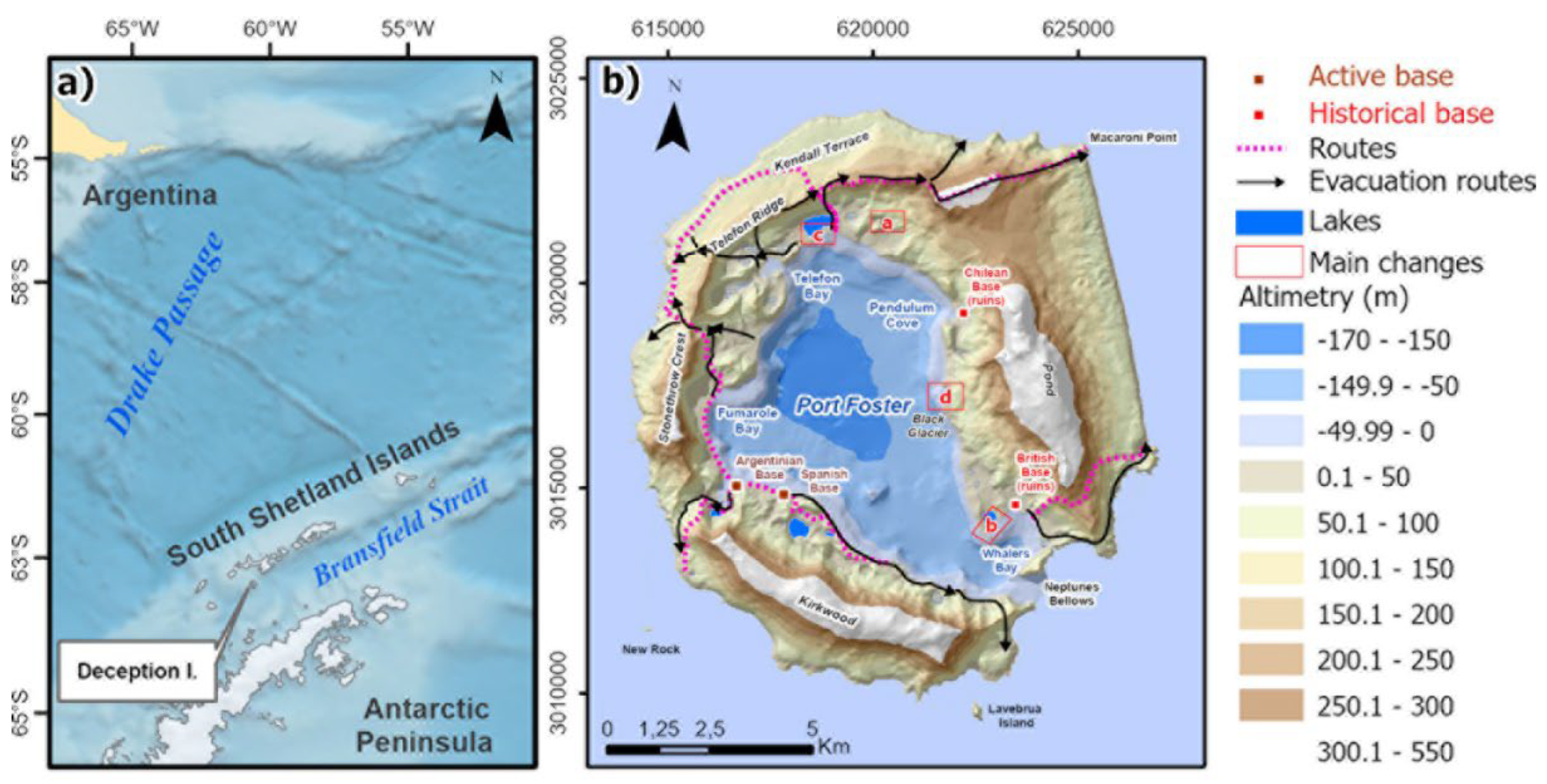
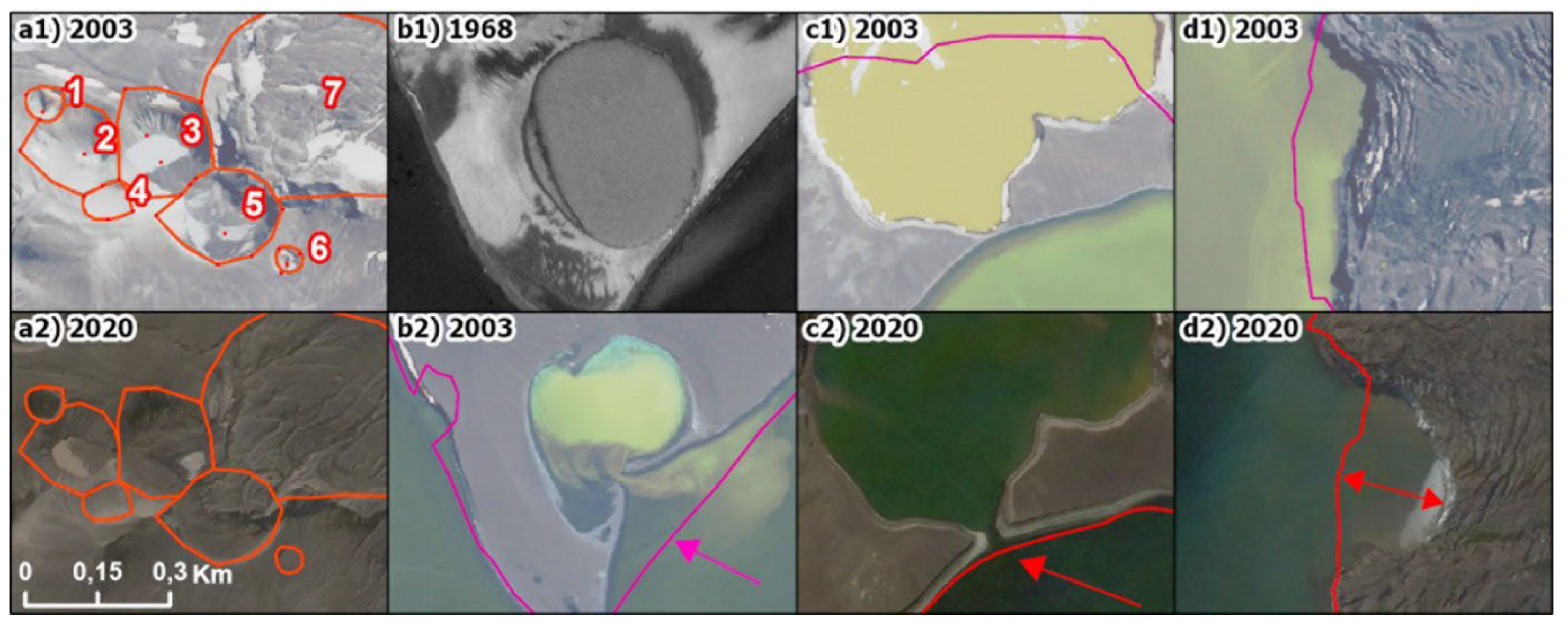
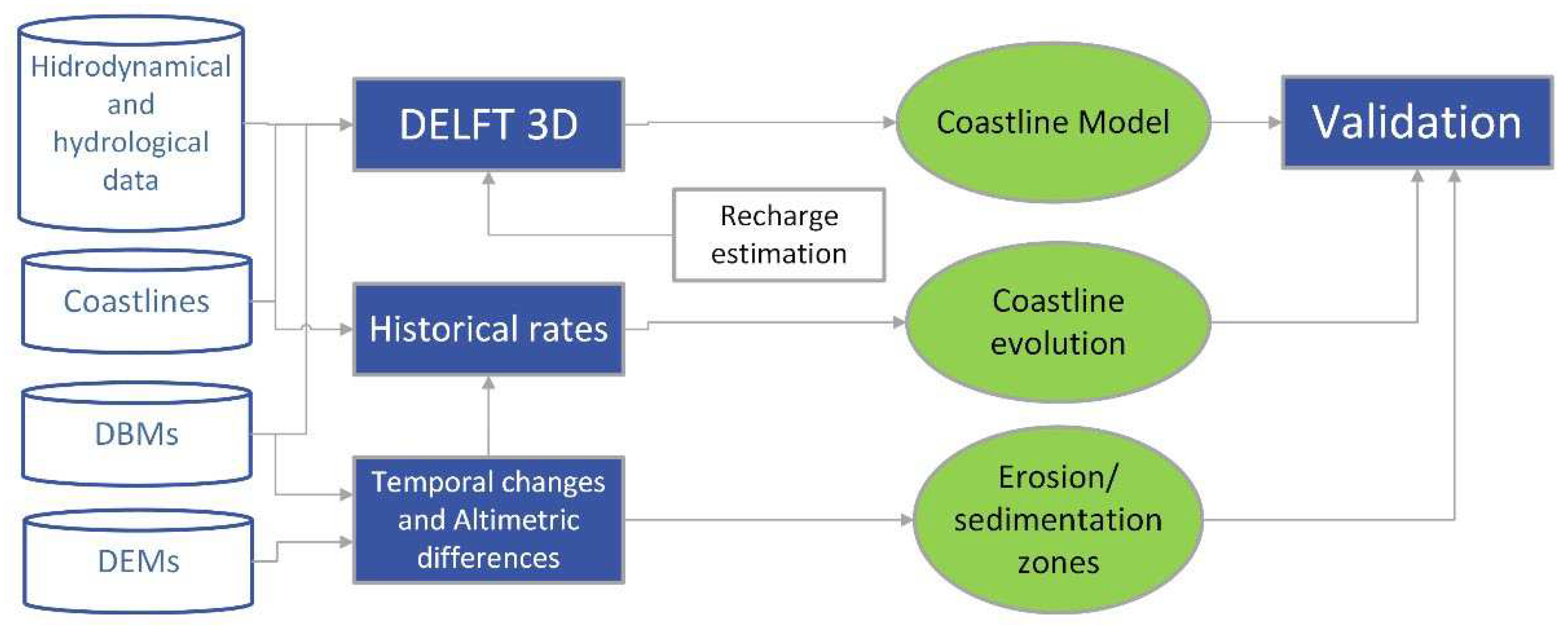
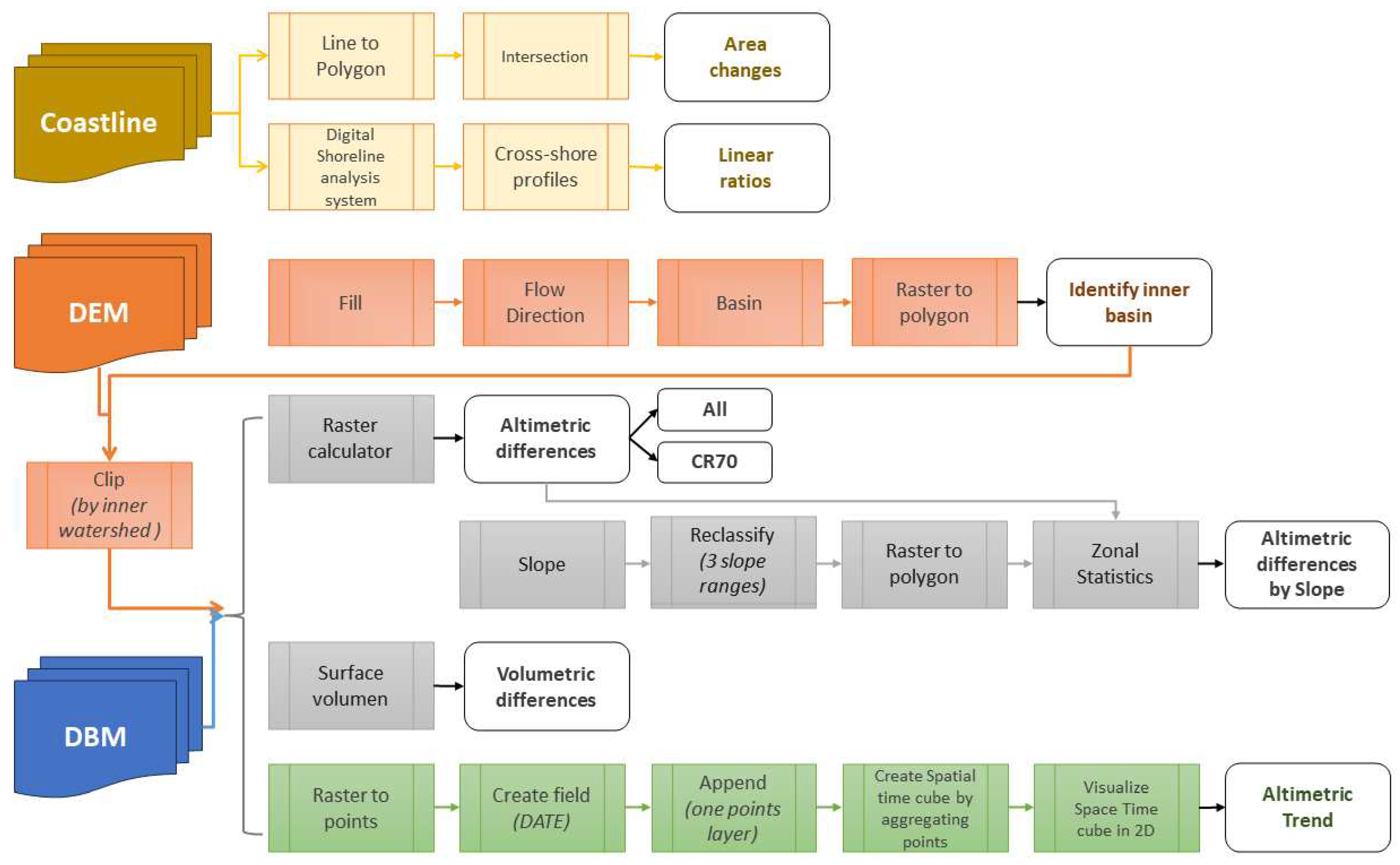
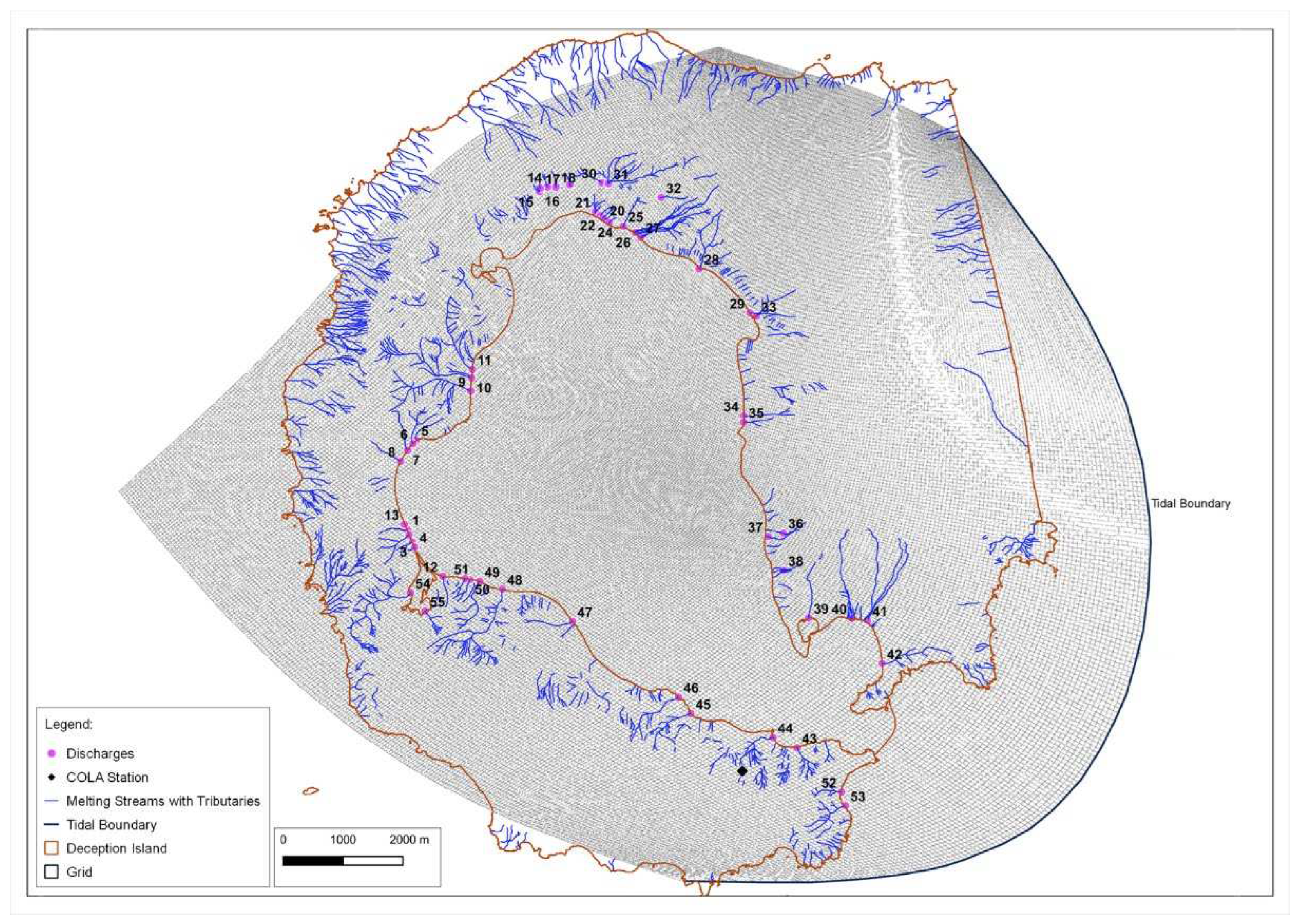


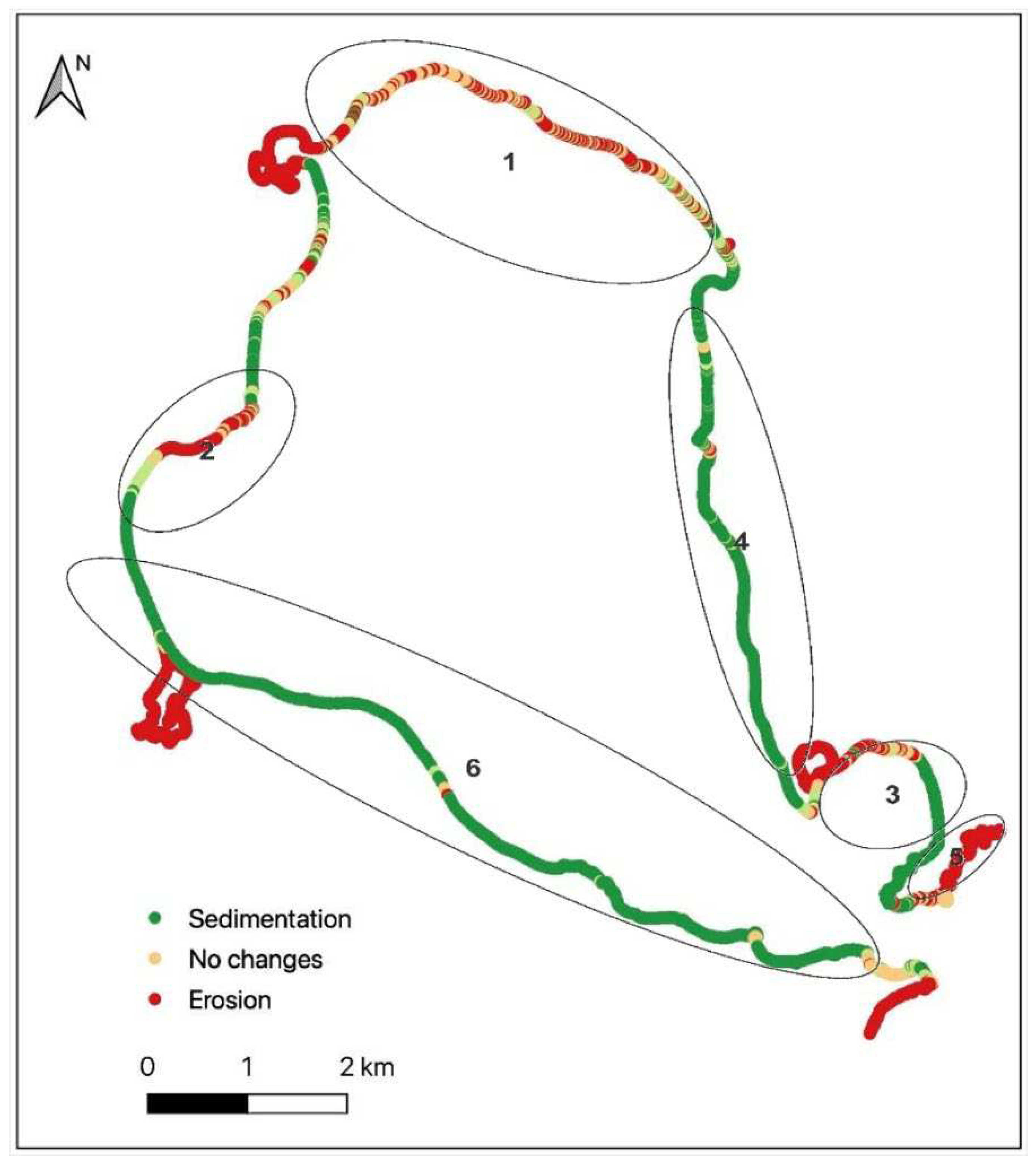
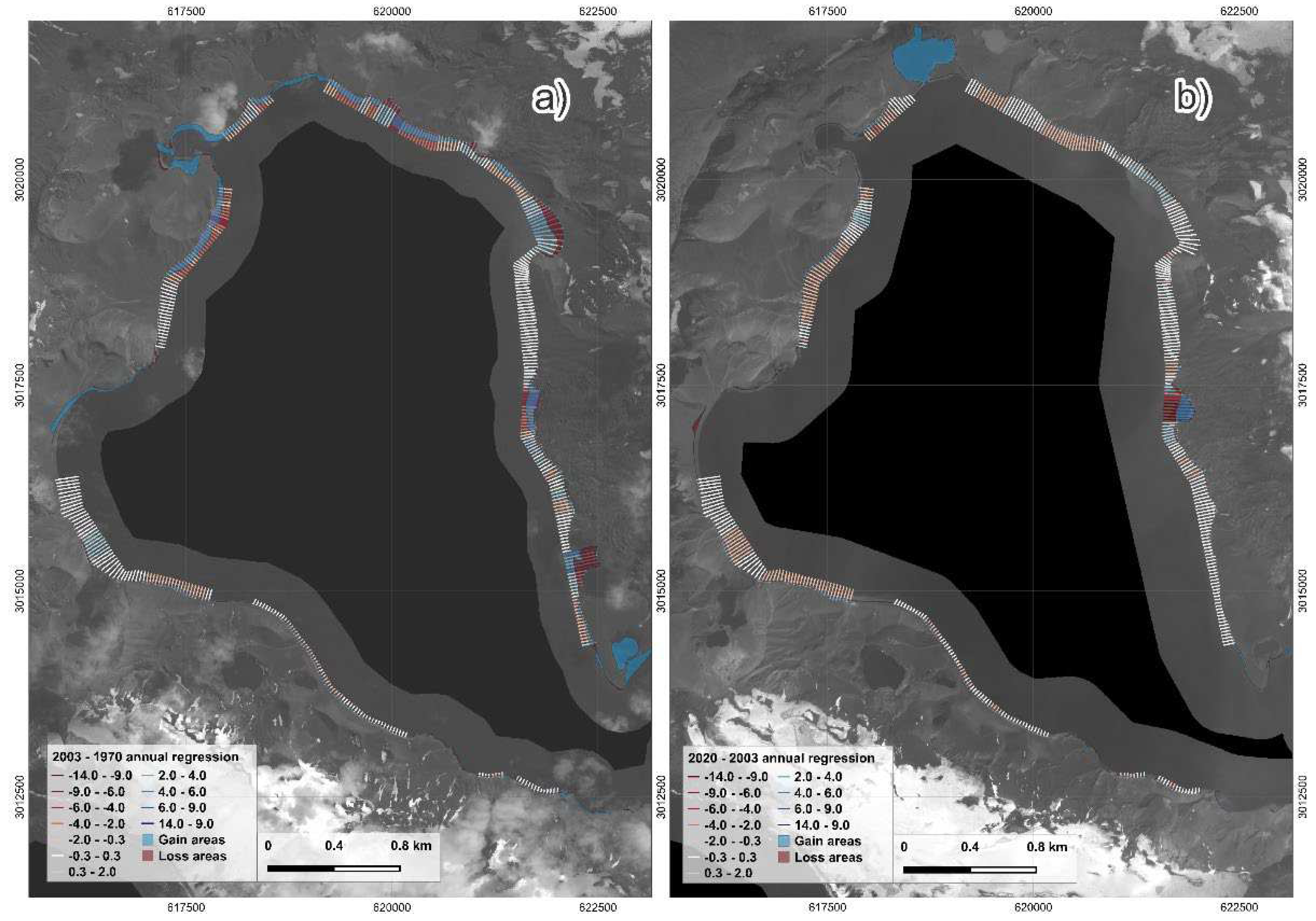
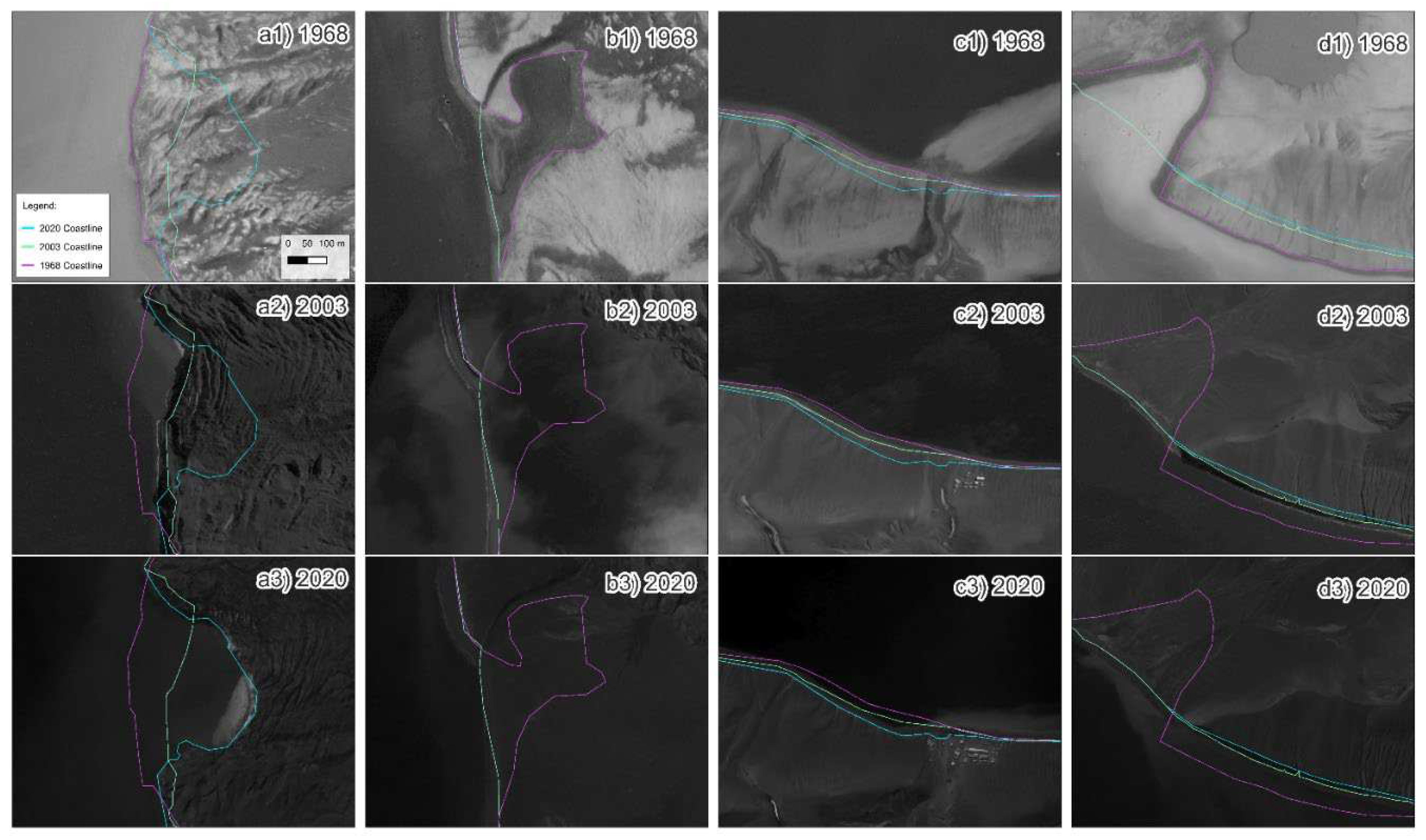

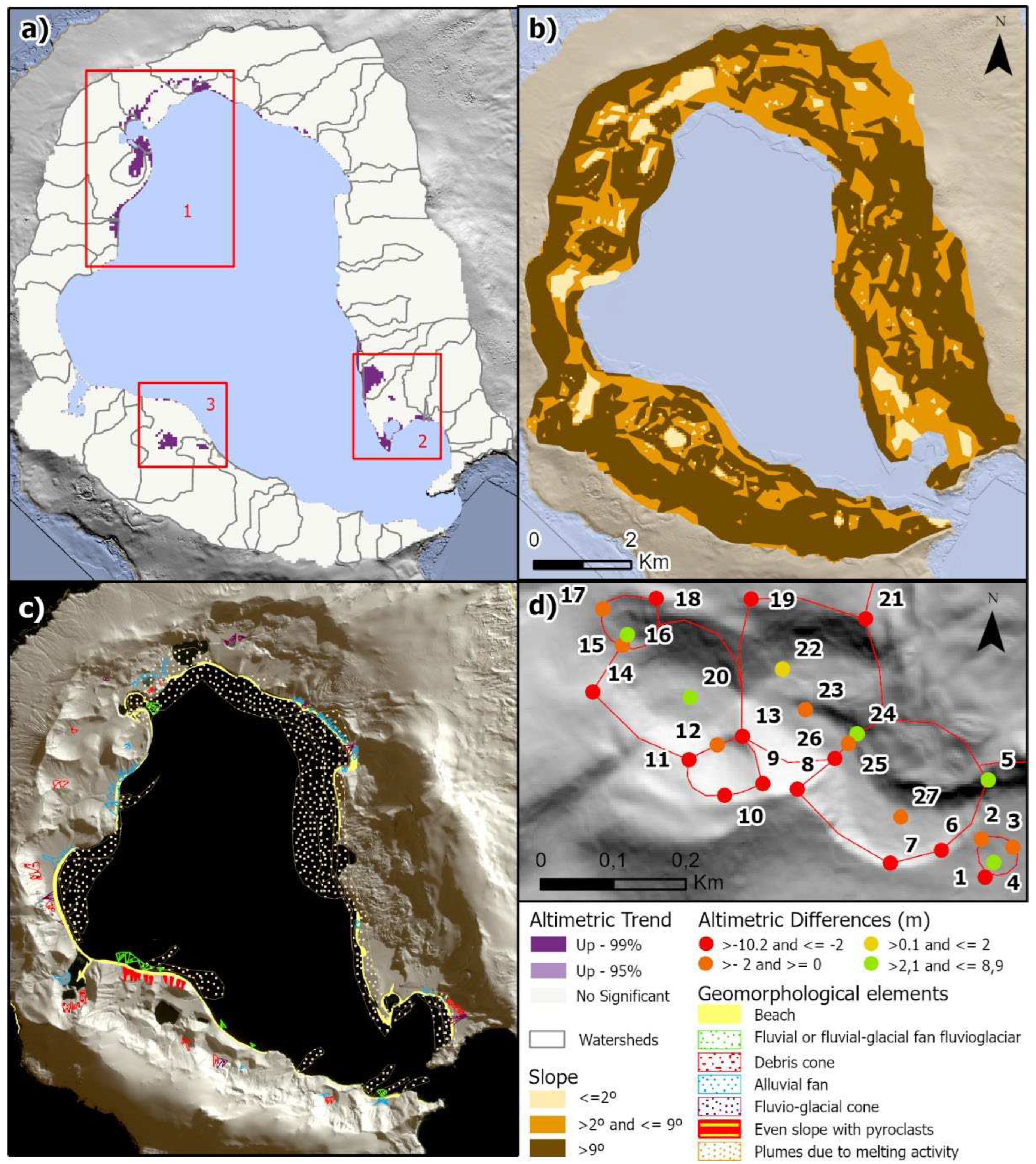
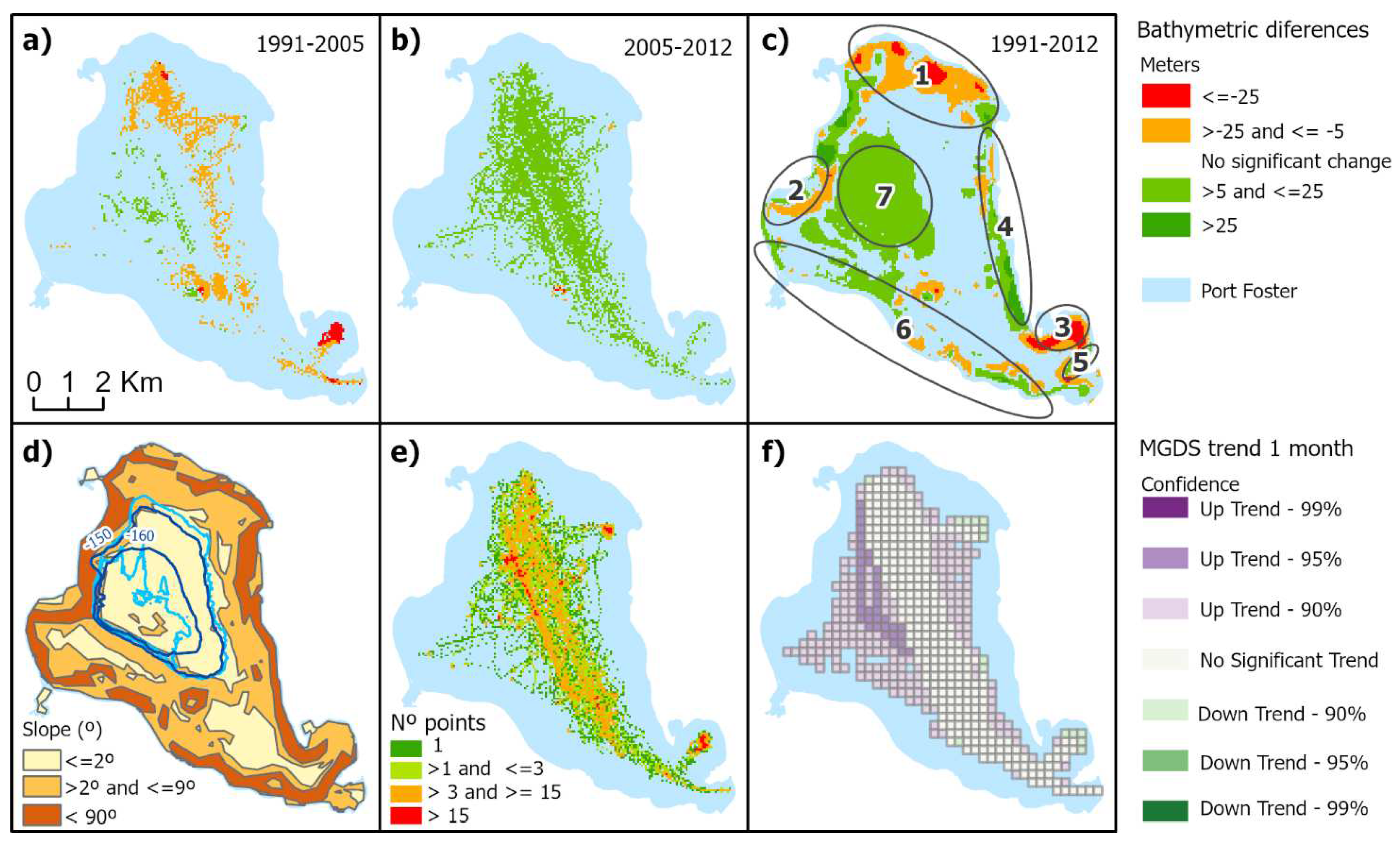
| Denomination | Digital Source | Description/ Spatial Resolution or Scale |
Date |
|---|---|---|---|
| 1968 orthophoto | Own from [26] | Orthophoto from FIDASE flight / 0.8 m |
1968 |
| New QB1 | Own from [3] | QuickBird Satellite image/ 0.6 m | 2003-jan-20 |
| K31 | Own from [26] | KOMPSAT-32 Satellite image/ 0.7 m | 2020-feb-09 |
| Sentinel images | ESA | Sentinel 2 Satellite Images/ 10 m |
2017-mar-30, 2019-feb-23, 2019-dec-30, 2020-feb-08, 2020-dec-27,2021-jan-13, 2021-jan-06, 2021-feb-02, 2022-mar-29 (snow cover) |
| Google Earth Images | Google Earth | Satellite images / several resolutions |
2002-jan-15, 2005-oct-20 (snow cover), 2013-dec-29. |
| Sediment plumes | Own from all satellite images | Visual delineation of sediment plumes | 2002-2022 |
| Level contours | SIMAC from CGE map | Line / 1:25 000 | 1970 and 2003 |
| Melting Streams | SIMAC from CGE map | Line / 1:25 000 | 1970 and 2003 |
| Coastline 1968 | Own from [26] | Line / 1:25 000 | 1968 |
| Coastline 1970 | SIMAC from [38] | Line / 1:25 000 | 1970 |
| Coastline 2003 | SIMAC from new QB | Line / 1:25 000 | 2003 |
| Coastline 2020 | Own from [26] | Line / 1:25 000 | 2020 |
| Geomorphological map | SIMAC from [32] | Group layers / 1:25 000 |
2002 |
| Denomination | Digital Source | Format Used/ Spatial Resolution |
Date |
|---|---|---|---|
| DOS DEM | SIMAC from [39] | ESRI Grid/ 20 m | 1956 |
| 1957 DEM | Own from [26] | Tiff file/ 2.7 m | 1957 |
| 1968 DEM | Own from [26] | Tiff file/ 2.7 m | 1968 |
| CGE DEM | SIMAC from CGE map | ESRI Grid/ 2 m | 1968 and 1986 |
| REMA | REMA [37] | Two Tiff files (45_04_2_2_2m_v2.0 and 45_05_2_1_2m_v2.0)/ 2 m | 2009-20211 |
| Denomination | Digital Source | Format Used/Spatial Resolution or Distance Between Points | Date |
|---|---|---|---|
| DBM CGE | Adapted from CGE/IHM/IEO [32] | ESRI Grid/ 2 m | 1988-91 |
| Bathymetry LMG0010 | MGDS [46] | Ten Dat files/ points in line each < 120 m | 2000 |
| Bathymetry LMG0102 | MGDS [47] | One Dat file/ points in line each < 120 m | 2001 |
| Bathymetry LMG0704 | MGDS [48] | Two Dat files/ points in line each < 120 m | 2007 |
| Bathymetry LMG0712 | MGDS [49] | One Dat file/ points in line each < 120 m | 2007 |
| Bathymetry LMG0903 | MGDS [50] | Four Dat files/ points in line each < 120 m | 2009 |
| DBM MGDS mean | Interpolated from previous MGDS | Esri Grid / 50 m | 20051 |
| DBM IHM | IHM [18] | Esri Grid / 10 m | 2012 (central bay) 2016 (some coastal zones) |
| External DBM South Shetlands | British Antarctic Survey [51] |
A Ascii file/ 100 m | 1991-2017 |
| u [m/s] | φ [º] | |||
| Measured | Computed | Measured | Computed | |
| M2 | 0.13 | 0.013 | 33 | 34 |
| K1 | 0.09 | 0.009 | 173 | 180 |
| Type | Difference | Area | Min/Max | Mean (m) | Std dev (m) |
|---|---|---|---|---|---|
| DEM | REMA-SIMAC | All | -84 / 74 | -2,3 | 8,1 |
| Flat (<=2º) | -1.2 | 3.7 | |||
| Medium slope (<=9º) | -3.4 | 7.1 | |||
| High slope (>9º) | -6 | 13.1 | |||
| 1968-1957 | All | -78 / 86 | 4 | 8.9 | |
| Flat (<=2º) | 1.4 | 8.4 | |||
| Medium slope (<=9º) | 3.6 | 9.4 | |||
| High slope (>9º) | 4.5 | 8.6 | |||
| SIMAC-1968 | All | -78 / 62 | -0.5 | 13 | |
| Flat | 3.4 | 7.1 | |||
| Medium slope | 0.2 | 10.9 | |||
| High slope | -0.7 | 13.8 | |||
| REMA-SIMAC | All | -84 / 74 | -6.9 | 12.2 | |
| Flat | -2.6 | 4.2 | |||
| Medium slope | -5.5 | 7.8 | |||
| High slope | -7.9 | 13.9 | |||
| REMA-1957 | All | -88 / 65 | -3.4 | 12 | |
| Flat | 2.2 | 8.3 | |||
| Medium slope | -1.6 | 12 | |||
| High slope | -4.1 | 12.2 | |||
| REMA-1968 | All | -94 / 56 | -7.5 | 12.4 | |
| Flat | 0.8 | 8.2 | |||
| Medium slope | -5.3 | 12.2 | |||
| High slope | -8.7 | 12.4 | |||
| DBM | SIMAC- MDGS mean |
All | -51 / 34 | -3.4 | 7.5 |
| Flat (<=2º) | -1.5 | 4.3 | |||
| Medium slope (<=9º) | -7.5 | 9.9 | |||
| High slope (>9º) | -12.5 | 15.7 | |||
| MDGS mean- IHM mean |
All | -51 / 34 | 5.8 | 3.4 | |
| Flat | 6.2 | 2.4 | |||
| Medium slope | 5.3 | 3.6 | |||
| High slope | 0.5 | 10.3 | |||
| SIMAC- IHM mean |
All | -50 / 76 | 1.5 | 10.8 | |
| Flat | 4.6 | 4.3 | |||
| Medium slope | -0.5 | 10.1 | |||
| High slope | -0.04 | 17.1 |
| Type | Dataset | Plane (m) | Reference | Area 3D (km2) | Vol. Land/ Water (km3) |
Dif. Vol. (km3) | Ratio (hm3 / yr) |
|---|---|---|---|---|---|---|---|
| DEM | REMA | 0 | ABOVE | 48,06 | 5,94 | -0,32 | -0,23 |
| 100 | ABOVE | 23,93 | 2,77 | -0,23 | -0,33 | ||
| 200 | ABOVE | 12,33 | 1,15 | -0,13 | -0,37 | ||
| 300 | ABOVE | 5,27 | 0,37 | -0,06 | -0,36 | ||
| 400 | ABOVE | 1,48 | 0,07 | -0,02 | -0,50 | ||
| CGE DEM | 0 | ABOVE | 48,02 | 6,26 | -0,03 | -0,03 | |
| 100 | ABOVE | 24,31 | 3,00 | -0,10 | -0,23 | ||
| 200 | ABOVE | 13,25 | 1,28 | -0,09 | -0,40 | ||
| 300 | ABOVE | 5,71 | 0,42 | -0,06 | -0,60 | ||
| 400 | ABOVE | 1,75 | 0,09 | -0,03 | -0,89 | ||
| 1968 DEM | 0 | ABOVE | 47,42 | 6,28 | 0,19 | 0,36 | |
| 100 | ABOVE | 25,50 | 3,10 | 0,13 | 0,46 | ||
| 200 | ABOVE | 14,19 | 1,37 | 0,09 | 0,55 | ||
| 300 | ABOVE | 6,46 | 0,48 | 0,06 | 0,78 | ||
| 400 | ABOVE | 2,12 | 0,12 | 0,03 | 1,38 | ||
| 1957 DEM | 0 | ABOVE | 47,17 | 6,10 | NA | ||
| 100 | ABOVE | 24,33 | 2,97 | NA | |||
| 200 | ABOVE | 13,51 | 1,29 | NA | |||
| 300 | ABOVE | 6,06 | 0,43 | NA | |||
| 400 | ABOVE | 1,84 | 0,09 | NA | |||
| DBM | DBM IHM1 | 0 | BELOW | 38,53 | 3,90 | 0,09 | 0,0966 |
| -100 | BELOW | 22,72 | 0,83 | 0,02 | 0,0004 | ||
| -150 | BELOW | 9,32 | 0,07 | -0,02 | -0,0010 | ||
| DBM CGE1 | 0 | BELOW | 37,76 | 3,81 | NA | ||
| -100 | BELOW | 20,81 | 0,81 | NA | |||
| -150 | BELOW | 8,60 | 0,09 | NA |
Disclaimer/Publisher’s Note: The statements, opinions and data contained in all publications are solely those of the individual author(s) and contributor(s) and not of MDPI and/or the editor(s). MDPI and/or the editor(s) disclaim responsibility for any injury to people or property resulting from any ideas, methods, instructions or products referred to in the content. |
© 2023 by the authors. Licensee MDPI, Basel, Switzerland. This article is an open access article distributed under the terms and conditions of the Creative Commons Attribution (CC BY) license (http://creativecommons.org/licenses/by/4.0/).





